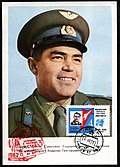 Vostok 3KA capsule | |
| Mission type | Low Earth orbital |
|---|---|
| Operator | Soviet space program |
| Harvard designation |
|
| SATCAT no. |
|
| Mission duration |
|
| Orbits completed |
|
| Spacecraft properties | |
| Spacecraft |
|
| Manufacturer | Experimental Design Bureau OKB-1 |
| Launch mass |
|
| Crew | |
| Crew size | 1 |
| Members |
|
| Callsign |
|
| Start of mission | |
| Launch date |
|
| Rocket | Vostok-K 8K72K |
| Launch site | Baikonur 1/5[4] |
| End of mission | |
| Landing date |
|
| Landing site |
|
| Orbital parameters | |
| Reference system | Geocentric |
| Regime | Low Earth |
| Perigee altitude |
|
| Apogee altitude | |
| Inclination | 65.0 degrees |
| Period | 88.5 minutes |
| Epoch | |

  Andryan G Nikolaiev / Pavel Popovich | |

Vostok 3 (Russian: Восток-3, lit. 'Orient 3' or 'East 3') and Vostok 4 (Восток-4, 'Orient 4' or 'East 4') were Soviet space program flights in August 1962, intended to determine the ability of the human body to function in conditions of weightlessness, test the ground control capability to launch and manage two separate, concurrent flights, and test the endurance of the Vostok 3KA spacecraft over longer flights. Cosmonaut Andriyan Nikolayev orbited the Earth 64 times in Vostok 3 over nearly four days in space, August 11–15, 1962, a feat which would not be matched by NASA until the Gemini program (1965–1966).[1] Pavel Popovich was launched on Vostok 4 on August 12, and made 48 Earth orbits. The two capsules were launched on trajectories that brought the spacecraft within approximately 6.5 km (4.0 mi) of each another.[7]
They also communicated with each other via radio, the first ship-to-ship communications in space.[8] These missions marked the first time that more than one crewed spacecraft was in orbit at the same time, giving Soviet mission controllers the opportunity to learn to manage this scenario.[9]
Although the two spacecraft were placed in very similar orbits (within 3-4 kilometers altitude), the Vostok did not possess the capability to achieve rendezvous. At one point they came within visual range of each other, and Popovich later reported at a news conference that he saw the other craft from orbit. Popovich is quoted as saying, "I saw it at once," referring to seeing Vostok 3 in orbit. "It looked like a very small moon in the distance."
Vostok 4 went largely as planned, despite a malfunction with the Vostok's life-support systems that caused cabin temperature to drop to 10 °C (50 °F). The flight was terminated early after a misunderstanding by ground control, who believed that Popovich had given them a codeword asking to be brought back ahead of schedule.[10]
The two spacecraft landed seven minutes and about 200 km apart, south of Karaganda, Kazakhstan.[11]
- ^ a b "NASA NSSDC Spacecraft Details". NASA. Retrieved 2009-03-17.
- ^ "NASA NSSDC Spacecraft Details". NASA. Retrieved 2020-12-04.
- ^ Yenne, Bill (1988). The Pictorial History of World Spaceflight. Exeter. p. 23. ISBN 0-7917-0188-3.
- ^ "Baikonur LC1". Encyclopedia Astronautica. Archived from the original on 2009-04-15. Retrieved 2009-03-04.
- ^ a b "NASA NSSDC Spacecraft Trajectory Details". NASA. Retrieved 2009-03-17.
- ^ a b "NASA NSSDC Spacecraft Trajectory Details". NASA. Retrieved 2020-12-04.
- ^ Gatland, Kenneth (1976). Manned Spacecraft, Second Revision. New York: Macmillan Publishing Co., Inc. pp. 117–118. ISBN 0-02-542820-9.
- ^ ""Group Space Flight" Described" (PDF). Flight. 82 (2790). London: Iliffe Transport Publications: 304–305. 30 August 1962. Retrieved 2009-03-17.
- ^ "Vostok 3". Encyclopedia Astronautica. Archived from the original on 2008-12-27. Retrieved 2009-03-21.
- ^ "Joint flight of Vostok-3 and Vostok-4". Russian Space Web. Archived from the original on April 26, 2019. Retrieved May 20, 2019.
- ^ "Soviet Spacemen Say No Try Made To 'Rendezvous'", TheMontreal Gazette newspaper, Aug 22, 1962